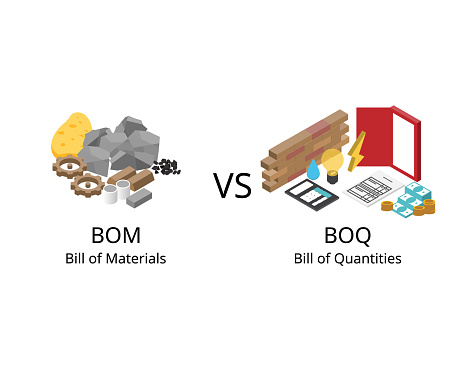How BIM is Improving BOQ/BOM Development Process

In the dynamic realm of construction and project
management, efficiency is paramount. Every aspect of the project lifecycle,
from planning and design to execution and maintenance, demands meticulous
attention to detail and streamlined processes. Among the critical components of
project management is the development of Bills of Quantities (BOQ) and Bills of
Materials (BOM), essential documents that outline the quantities and
specifications of materials required for construction. Traditionally, this
process has been labor-intensive and prone to errors. However, with the advent
of Building Information Modeling (BIM), this aspect of project management is
undergoing a profound transformation, leading to enhanced accuracy, efficiency,
and cost savings.
What is a Bill of Materials (BoM)?
Imagine a recipe for a building! That's essentially
what a Bill of Materials (BoM) is. It's a detailed list of all the ingredients
(components and parts) needed to build a product, from the tiniest screw to the
biggest beam. Here's what makes a BoM so valuable:
- It's precise: Each component has its own manufacturer
part number (MPN) and the exact quantity needed, ensuring you have everything
to build your product accurately. - It's multi-layered: Complex products often have
smaller sub-assemblies, and the BoM can dive into each level, listing all the
components needed for each sub-assembly. - It's informative: Beyond just the part number and
quantity, the BoM can include details like:
- Approved manufacturers (AML): Ensures you get the
right quality from trusted suppliers. - Mechanical characteristics: Understands the size,
material, and other technical properties of each component.
- Additional descriptors: Any other relevant information
like color, finish, or specific function.
What is BoQ (Bill of Quantity)?
Think of the BoQ as a comprehensive, itemized list of
all the materials and labor needed to complete your construction project. It's
not just a simple list though, it's a key document that plays several crucial
roles:
- Tendering: When you put your project out for bids, the
BoQ helps contractors understand the scope of work and accurately estimate
their costs. This ensures fair competition and helps you choose the best offer. - Contractual agreement: Once you select a contractor,
the BoQ forms the basis of your contract, clearly outlining the expected
deliverables and ensuring both parties are on the same page. - Project management: Throughout the project, the BoQ
serves as a valuable reference point, helping you track progress, manage costs,
and identify any potential deviations.
How BIM Transforms BOQ/BOM Development
For construction projects, accuracy and efficiency are
paramount. That's where the Bill of Quantities (BOQ) and Bill of Materials
(BOM) come in, providing a detailed breakdown of all materials and components
needed. However, traditional BOQ/BOM development can be riddled with errors,
inconsistencies, and delays. Enter Building Information Modeling (BIM), a
revolutionary technology transforming the way we build, and improving BOQ/BOM
development in several ways.
BIM: More Than Just 3D Models
BIM goes beyond creating pretty 3D models. It's a
collaborative platform housing a wealth of information about every building
component, from size and material to location and connections. This rich data
becomes the foundation for smarter BOQ/BOM development:
- Automatic Quantity Extraction: Forget manually
counting bricks or measuring pipes. BIM automatically extracts quantities
directly from the model, eliminating errors and saving countless hours. - Enhanced Material Identification: Each element in the
BIM model carries its specific material properties and specifications, allowing
for precise BOM generation with accurate quantities and descriptions. - Clash Detection and Error Prevention: BIM identifies
potential design clashes early in the process, preventing errors that would
later impact BOQ/BOM accuracy and lead to costly rework. - Real-Time Updates and Transparency: Changes made to
the BIM model automatically reflect in BOQ/BOM, ensuring everyone involved has
access to the latest information and minimizing communication gaps. - Improved Collaboration: Shared BIM models facilitate
collaborative BOQ/BOM development, allowing stakeholders from different
disciplines to contribute and review data in real-time.
Benefits Beyond Efficiency
The impact of BIM on BOQ/BOM development extends
beyond just saving time and money. Here's what you can expect:
- Reduced Costs: Accurate BOQs lead to more precise
procurement and minimize material waste, saving money throughout the project. - Faster Project Delivery: Streamlined BOQ/BOM
development accelerates the overall construction timeline. - Improved Decision-Making: Data-driven insights from
the BOQ/BOM empower informed decisions about materials, procurement strategies,
and project costs. - Enhanced Sustainability: Optimized material quantities
and reduced waste contribute to a more sustainable building process.
Conclusion
In conclusion, Building Information Modeling (BIM) is
revolutionizing the BOQ/BOM development process, offering unparalleled
accuracy, efficiency, and cost savings. By leveraging the rich data and
visualization capabilities of BIM models, project managers can streamline
quantity takeoffs, improve collaboration, and generate more accurate cost
estimates. As BIM continues to gain traction in the construction industry, its
impact on BOQ/BOM development is poised to grow, ushering in a new era of
efficiency and productivity in construction project management.












